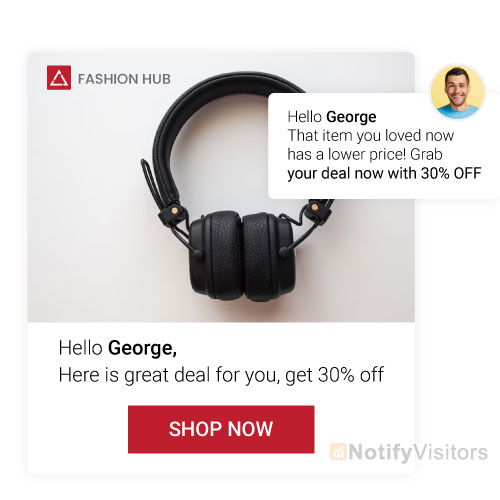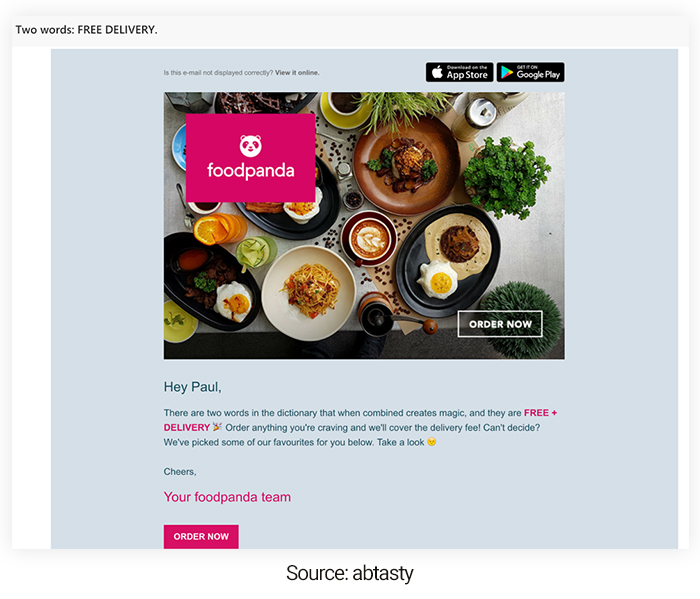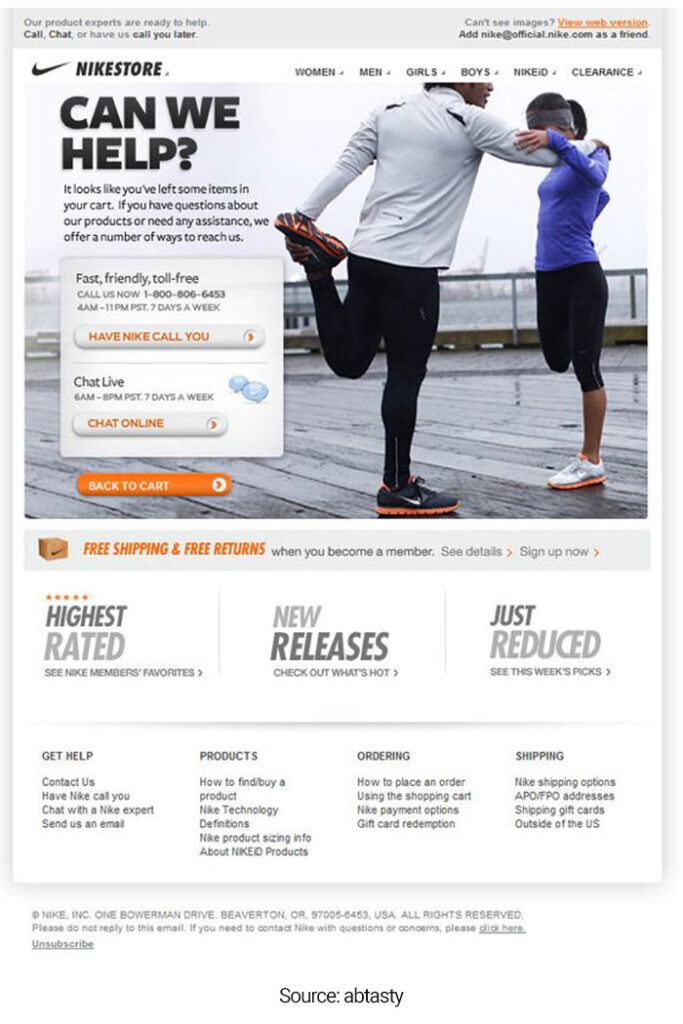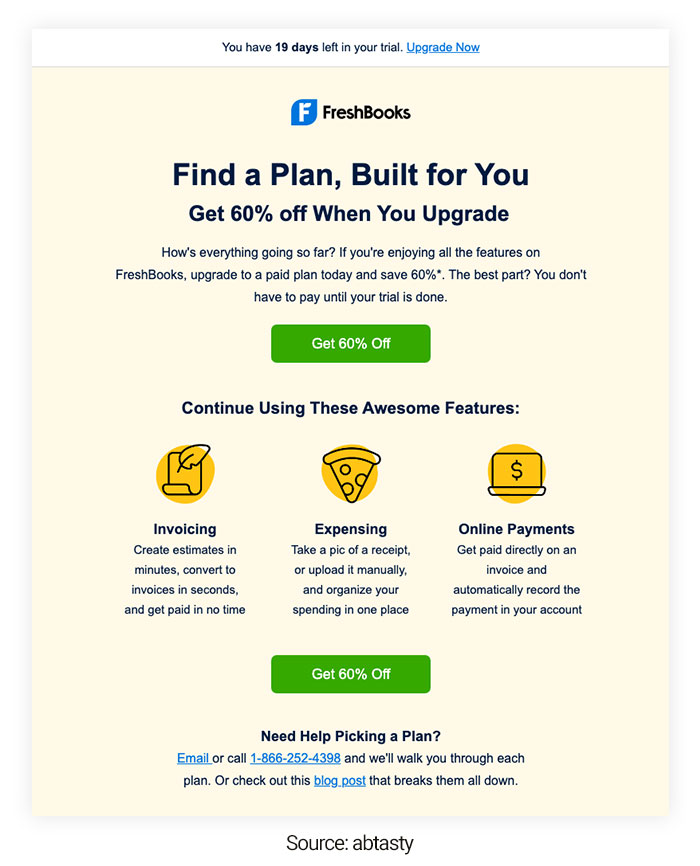For an e-commerce business, getting users to learn about your brand/website and turning those visitors into consumers is at the core of a good marketing strategy.
If you’re an e-commerce business owner, you understand these leads’ importance. Since they have already seen your website and expressed purchase intent, they’re much more likely to turn than those who have not heard about you.
This is where retargeting comes in – it lets you engage those visitors and convert them with a smart campaign. This post will cover everything you need to know about email retargeting.
Contents
What is email retargeting?
Email retageting comprises capturing and utilizing information about your customers to obtain better marketing results through personalized email marketing campaigns.
When a visitor browses a website, marketers can get navigation data using a browser cookie. A browser cookie is a small file that tracks behavior and activities for each visit.
Like retargeted ads, email retargeting campaigns utilize behavioral and action-based information to tailor personalized email campaigns further. However, email retargeting can also develop retargeted ads on social media and display networks.
How does email retargeting work?
Like ad retargeting, email retargeting is initiated by visitors’ behaviour on your website, usually tracked by browser cookies.
However, unlike ad retargeting, which allows you to retarget unknown visitors after leaving your website, email retargeting can only reach visitors in your email subscriber lists.
While email retargeting may have a smaller reach, it allows marketers to create a highly personalized experience.
Email retargeting and ads retargeting are complementary to each other. On average, marketers utilizing both retargeting strategies have a 2x conversion rate and faster conversion time.
It only functions when you use the data about shoppers to develop highly targeted marketing relevant to their shopping behaviours — what they’ve bought previously, what they want, and what they require.
Email retargeting works best for brands that:
- Suffer high cart abandonment rates.
- Have a significant number of window shoppers who aren’t taking action.
- Want to personalize promotions to email subscribers?
- Have huge options to upsell products to existing customers.
Do’s and don’ts of email retargeting
Here are the dos and don’ts of email retargeting that you should consider.
Do:
- Prepare a simple yet engaging email subject line, and try to personalize it.
- Experiment with different calls to action.
- Keep your message interesting and clear.
- Monitor the quality of your content.
- Look for spelling or grammatical errors.
- Build a positive user experience.
- Monitor email frequency to bypass overloading your subscribers with information.
Don’t:
- Make your email campaign too promotional.
- Send emails numerous times in rapid succession.
- Buy a list of email prospects.
- Use unbranded email addresses.
- Use the same email message or content frequently.
When Should You Use Email Retargeting?
1. Retarget website visitors

Numerous shoppers visiting your website will check product categories, read some reviews, maybe even go through your FAQ page… and leave without ever adding anything to their carts.
How to engage these shoppers who give up halfway through your sales funnel?
With email retargeting, reengaging with these passive visitors becomes easy.
2. Retarget shoppers with abandoned carts.
A tremendous way for ecommerce brands to leverage email retargeting is by recovering abandoned carts. According to Statista, 3 out of 4 customers will leave their shopping carts halfway through their checkout journey.
When it comes to recovering these lost sales, email retargeting is an opportunity for you to:
- Remind shoppers of the products they had demonstrated an interest in.
- Repeat your value proposition by incorporating the top reviews for the products they left in their carts.
- Develop a sense of urgency and FOMO — here’s where countdown timers can come in handy.
- Show a small perk prompting them to continue shopping, such as free shipping or a small discount. (A huge reason shoppers abandon their carts is unpredictable shipping fees.)
3. Cross-sell/upsell customers after purchase
One of the benefits of email retargeting is how effortless it is to segment your audiences.
You should consider cross-selling or upselling customers who have just bought the product in case they haven’t fully explored your product catalog during their shopping journey.
You can:
- Boost products that would work well with the ones that they just bought.
- Remind them of your value propositions and brand promises.
- Prompt them to add to their order before shipping the package at no additional cost.
- Give them a small discount automatically applied to their next purchase.
Now that you understand when to use email retargeting let’s jump into some of the best practices.
Email Retargeting Best Practices
1. Collect user data and segment it

Before you start sending out emails, you must understand your audience. You can consider this in terms of your products – which ones are the most prevalent, and which price range is the most well-known?
But you should go even further and understand your visitors – what are their demographics, interests, earnings, and purchasing habits?
You can get all this information by analyzing your social media and web analytics. For instance, Google Analytics contains a pretty simple dashboard that can offer you an overview of your visitors.
Facebook also includes a similar overview that can inform you a lot about your audience:
Analyzing these metrics can support you in developing buyer personas and engaging each individual with a tailored offer.
In simpler terms, this implies you shouldn’t engage different types of customers with the same message. Segment your audience into smaller groups, build a buyer persona for each one, and start working on personalized offers.
- Demographics- Age, sex, and employment type – are essential criteria to differentiate between groups of users. If you’re a fashion store, you wouldn’t like to offer skirts to men, would you? You also wouldn’t like to offer the same products to teenagers, young adults, and older adults.
- Purchasing power- Do you own “high-rollers” that spend thousands of dollars a year on your most costly products? They should get personalized emails with such products. On the contrary, the “discount-seekers” will likely want promotional offers with more affordable products.
- Purchase history- You might have consumers that choose one type of product over the others. To return to the fashion store instance, perhaps you have a female customer who adores your shoes. If you have a group of such customers, targeting them with an email can be a great idea when you have a big shoe sale.
2. Think about your goals
When putting up your email campaign, your goals dictate much of your execution.
In most cases, your goal will be to boost sales.
Unfortunately, it’s not as easy as this – you must get more in-depth and think about your campaign objectives rather than business goals.
What does this mean?
Let’s consider two scenarios.
In the first scenario, a person notices your social media ad, browses through your website, and shuts the tab. In the second scenario, we have someone who did the same thing but put three products in the cart and abandoned them.
From a business standpoint, your purpose for these two visitors is the same: turn them into customers. From a campaign standpoint, these two users showed different behaviours, so they’ll require completely different campaigns.
You can target the first with new products similar to those they’ve already browsed. Let’s say they browsed through sneakers – you can send them an email when you get a new collection since they may not like your offer the first time.
The second visitor has no issue with your offer – they already expressed strong purchase intent. They should be engaged with a different email, presenting a small discount, free shipping, or updated prices.
3. Personalized emails

Now, it’s time to write the actual emails. Researching your audience, segmenting it into smaller groups, and engaging them with tailored offers – that’s exactly what personalization is.
You can use your customers’ names, job titles, and purchasing habits to make a personal connection to enhance your game.
To impress them, you can utilize personalized images to get a strong reaction. Suppose one of your customers obtains a personalized email with a tailored offer, their name mentioned, and an image with their name on it.
Your approach will likely delight them even if they aren’t interested in the offer. Studies indicate that personalized emails can improve your transactional rates by up to six times.
4. Offer something of value
This step is extremely important for those users who abandoned the purchasing process.
Something happens if someone scans through your website, places the products in the cart, and then quits.
They didn’t like something: your offer, prices, shipping costs, etc. Therefore, sending a retargeting email to a website visitor is not enough, hoping they will relish the gesture and return to complete the purchase.
Depending on when they leave, you must offer them something worth their attention.
- If they put the products in the cart and then abandon them, offer them free shipping or a discount for the cart’s total value. This is ideal for engaging customers in the last stage of the process.
- If they browsed through the offer but didn’t put anything in the cart, send them an email with new, better products that they might have forgotten. There is no point in returning them to the website to check out the same offer they’ve already noticed.
- If they bought a product, show them a complementary product immediately or from the same category in a few weeks/months. So, if someone just bought a pair of shoes, it doesn’t make sense to send them your latest shoe collection that same day. You can do that after a few months.
5. Track KPIs and adopt
You’ll have to utilize metrics to notice what works as you work on your strategy.
If you segment your audience appropriately, you’ll be able to notice which groups are the most likely to convert.
That way, you can stop wasting time on those groups that do not require your attention and focus your money and resources on those that are.
Email open and conversion rates are the most crucial stats you should always be aware of.
5 examples of email retargeting campaigns
1. FoodPanda

FoodPanda understands that hunger cannot wait. The image above indicates that they retarget with two magical words: “free+delivery.”
A simple free delivery proposal could be all it takes to persuade your customer to try a new restaurant they’ve already been looking at.
2. Debenhams

In Debenhams’ email retargeting campaign, they mentioned items a customer was browsing but that they hadn’t added to their cart.
This email also contains enticing CTAs for buyers: free next-day click & gather and fuss-free returns. What more could you ask for?
Interestingly, this email doesn’t say the customer’s name, but it still feels personal as it targets customers viewing the product.
3. Nike

Similarly, Nike begins a retargeted email after you’ve left some items in your cart.
While they don’t show your abandoned items, they urge you to talk with a sales representative over the phone or through their online chat.
Finally, they heavily emphasize their “free shipping – free returns” policy to persuade undecided customers.
This is extremely important to highlight, considering that shipping cost is one of the major reasons for cart abandonment.
4. Duolingo

Duolingo, a language-learning app, uses a different approach in its retargeting campaign: emotion.
If you haven’t utilized the app recently, they let you know that you haven’t been seen in a while and that it’s time to get back on track with your learning.
They even take it to another level by saying that you’ve made Duo the owl, the face of their app, sad because of your absence.
This is a wonderful way to apply human emotion to a retargeting campaign to re-engage users.
5. Freshbook

In this email retargeting email example, with 19 days left in a free trial, Freshbook shows 60% off any plan for your upgrade. This not only draws the user with a discount but also reminds them that this offer is time sensitive according to how much of their free trial they have used.
Conclusion
Email retargeting is a strategy that perfectly follows the global trend of user-centric marketing.
It’s all about understanding your audience, segmenting it, and utilizing tailored offers to get their attention. Doing otherwise is a waste of resources and a surefire way to remain behind your competition.
NotifyVisitors ensures that you retarget your customers in the right way. With our recurring campaign option, you can do email retargeting. To know more about our software, schedule a free demo.
Also Read:

























 Email
Email SMS
SMS Whatsapp
Whatsapp Web Push
Web Push App Push
App Push Popups
Popups Channel A/B Testing
Channel A/B Testing  Control groups Analysis
Control groups Analysis Frequency Capping
Frequency Capping Funnel Analysis
Funnel Analysis Cohort Analysis
Cohort Analysis RFM Analysis
RFM Analysis Signup Forms
Signup Forms Surveys
Surveys NPS
NPS Landing pages personalization
Landing pages personalization  Website A/B Testing
Website A/B Testing  PWA/TWA
PWA/TWA Heatmaps
Heatmaps Session Recording
Session Recording Wix
Wix Shopify
Shopify Magento
Magento Woocommerce
Woocommerce eCommerce D2C
eCommerce D2C  Mutual Funds
Mutual Funds Insurance
Insurance Lending
Lending  Recipes
Recipes  Product Updates
Product Updates App Marketplace
App Marketplace Academy
Academy

